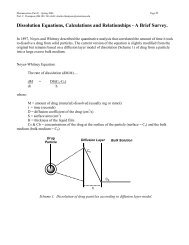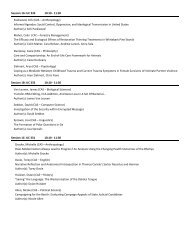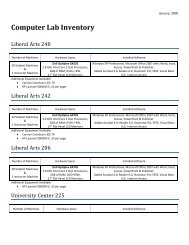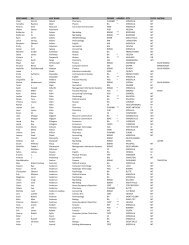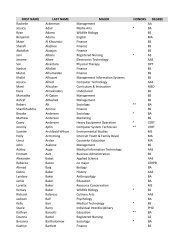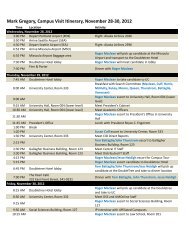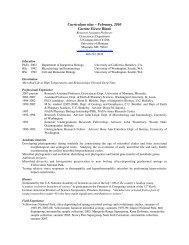Combinatorial Proof of an Abel-type Identity - The University of ...
Combinatorial Proof of an Abel-type Identity - The University of ...
Combinatorial Proof of an Abel-type Identity - The University of ...
You also want an ePaper? Increase the reach of your titles
YUMPU automatically turns print PDFs into web optimized ePapers that Google loves.
<strong>Combinatorial</strong> <strong>Pro<strong>of</strong></strong> <strong>of</strong> <strong>an</strong> <strong>Abel</strong>-<strong>type</strong><br />
<strong>Identity</strong> ∗<br />
P. Mark Kayll<br />
Department <strong>of</strong> Mathematical Sciences, <strong>University</strong> <strong>of</strong> Mont<strong>an</strong>a<br />
Missoula MT 59812-0864, USA<br />
mark.kayll@umont<strong>an</strong>a.edu<br />
David Perkins<br />
Department <strong>of</strong> Mathematics <strong>an</strong>d Computer Science<br />
Houghton College, Houghton NY 14744, USA<br />
david.perkins@houghton.edu<br />
<strong>Identity</strong> (1) below resulted from our investigation in [21] <strong>of</strong> chip-firing<br />
games on complete graphs Kn, for n ≥ 1; see, e.g., [2] for <strong>an</strong>tecedents.<br />
<strong>The</strong> left side expresses the sum <strong>of</strong> the probabilities <strong>of</strong> a game experiencing<br />
firing sequences <strong>of</strong> each possible length ℓ = 0,1,...,n. This note gives a<br />
combinatorial pro<strong>of</strong> that these probabilities sum to unity.<br />
We first m<strong>an</strong>ipulate<br />
n − 1<br />
n + 1 +<br />
n�<br />
ℓ=1<br />
� � ℓ−1 n−1−ℓ<br />
n ℓ (n + 1 − ℓ)<br />
ℓ n(n + 1) n−1 = 1 (1)<br />
into a form amenable to combinatorial pro<strong>of</strong>. Multiplying by n(n+1) n <strong>an</strong>d<br />
using the relation � � � � n n+1<br />
ℓ = ℓ (n + 1 − ℓ)/(n + 1), we tr<strong>an</strong>sform (1) to the<br />
equivalent form<br />
n�<br />
� �<br />
n + 1<br />
ℓ<br />
ℓ<br />
ℓ−2 (n + 1 − ℓ) n−1−ℓ ℓ(n + 1 − ℓ) = 2n(n + 1) n−1 . (2)<br />
ℓ=1<br />
To see that (2) holds, first observe that the right side enumerates the<br />
pairs (T,�e ), where T is a sp<strong>an</strong>ning tree <strong>of</strong> Kn+1 for which one edge e (<strong>of</strong><br />
2000 MSC: Primary 05A19; Secondary 05C30, 60C05.<br />
∗ Preprint to appear in J. Combin. Math. Combin. Comput.<br />
1
its n edges) has been distinguished <strong>an</strong>d oriented (in one <strong>of</strong> two possible<br />
directions). <strong>The</strong> left side also enumerates these pairs. Given (T,�e ), notice<br />
that deleting the oriented edge �e from T leaves behind a sp<strong>an</strong>ning forest <strong>of</strong><br />
Kn+1 with two components L, R (that we may consider ordered from left to<br />
right). If |V (L)| = ℓ, for <strong>an</strong> integer ℓ with 1 ≤ ℓ ≤ n, then |V (R)| = n+1−ℓ.<br />
Conversely, given such a sp<strong>an</strong>ning forest, we c<strong>an</strong> recover (T,�e) by selecting<br />
a node x <strong>of</strong> L <strong>an</strong>d a node y <strong>of</strong> R <strong>an</strong>d letting �e = (x,y). On the left<br />
side <strong>of</strong> (2), the factor � � n+1<br />
accounts for the selection <strong>of</strong> V (L) (hence for<br />
ℓ<br />
the selection <strong>of</strong> V (R)). Since L, R are, respectively, sp<strong>an</strong>ning trees <strong>of</strong> the<br />
induced (complete) subgraphs Kn+1[V (L)], Kn+1[V (R)], the factors ℓℓ−2 <strong>an</strong>d (n + 1 − ℓ) n−1−ℓ are delivered by Cayley’s Formula [5]. Finally, the<br />
factors ℓ, (n+1−ℓ) count the number <strong>of</strong> ways to select the vertices x ∈ V (L)<br />
<strong>an</strong>d y ∈ V (R) determining �e.<br />
Epilogue<br />
Having attempted to prove (2) before realizing that it follows from established<br />
identities, we fortuitously discovered the pro<strong>of</strong> above. Here, we<br />
outline a multitude <strong>of</strong> connections between (2) <strong>an</strong>d the work <strong>of</strong> authors who<br />
preceded us. Our presentation order is mainly chronological.<br />
For integers r, n with 1 ≤ r ≤ n, we denote by Tn the number <strong>of</strong><br />
sp<strong>an</strong>ning trees <strong>of</strong> Kn <strong>an</strong>d by Fn,r the number <strong>of</strong> sp<strong>an</strong>ning forests <strong>of</strong> Kn<br />
that consist <strong>of</strong> r disjoint trees such that r specified nodes (roots) belong<br />
to distinct trees. We thrice invoked Cayley’s Formula, Tn = n n−2 , in our<br />
pro<strong>of</strong> above <strong>an</strong>d shall connect one <strong>of</strong> its generalizations,<br />
to (2) in our discussion below.<br />
Fn,r = rn n−r−1 , (3)<br />
As it turns out, (2) goes back (at least) to 1917, when Dziobek [10] used<br />
it in the form<br />
n−1 �<br />
� �<br />
n<br />
TℓTn−ℓ ℓ(n − ℓ) = 2(n − 1)Tn<br />
ℓ<br />
(4)<br />
ℓ=1<br />
to give, among other results, <strong>an</strong> inductive pro<strong>of</strong> <strong>of</strong> Cayley’s Formula. Bol [3]<br />
also proved <strong>an</strong>d applied (4) in deriving a generating-function identity for<br />
the numbers Tn. Of course, once Cayley’s Formula is known, then (4) yields<br />
a pro<strong>of</strong> <strong>of</strong> (2).<br />
Clarke [6] determined the number Tn,d <strong>of</strong> sp<strong>an</strong>ning trees <strong>of</strong> Kn with a<br />
specified node <strong>of</strong> valency d ≤ n − 1: Tn,d = � � n−2 n−d−1<br />
d−1 (n − 1) . Thus, the<br />
number <strong>of</strong> sp<strong>an</strong>ning trees <strong>of</strong> Kn+2, with, say, the node (n + 2) <strong>of</strong> valency<br />
2
2, is<br />
Tn+2,2 = n(n + 1) n−1 . (5)<br />
One obtains a combinatorial pro<strong>of</strong> <strong>of</strong> (5)—reminiscent <strong>of</strong> our pro<strong>of</strong> <strong>of</strong> (2)—<br />
by reverse-subdividing at the bivalent node (n + 2) <strong>an</strong>d noticing that then<br />
Tn+2,2 enumerates the sp<strong>an</strong>ning trees <strong>of</strong> Kn+1 with a distinguished (but<br />
not oriented) edge. In due course, we indicate a more direct connection<br />
between (5) <strong>an</strong>d (2).<br />
<strong>The</strong> year 1959 saw two more appear<strong>an</strong>ces <strong>of</strong> (2) in the literature. Dénes [9]<br />
proved (2) in <strong>an</strong> article where he showed that Tn gives the number <strong>of</strong> ways<br />
<strong>of</strong> representing a cyclic permutation (1,2,...,n) as a product <strong>of</strong> (n − 1)<br />
tr<strong>an</strong>spositions. <strong>The</strong>n Rényi [23], in proving (3), established a generalization<br />
<strong>of</strong> (2) <strong>an</strong>d cited [10, 9] as two earlier sources <strong>of</strong> the identity. Although<br />
(3) was stated by Cayley [5], Rényi’s paper probably contains the first published<br />
pro<strong>of</strong> <strong>of</strong> this result. Close on its heels, however, was <strong>an</strong> argument by<br />
Göbel [15], who showed that<br />
n−r �<br />
�<br />
n − r<br />
Fn,r =<br />
k<br />
k=1<br />
�<br />
r k Fn−r,k<br />
<strong>an</strong>d then used this recurrence to prove (3) inductively.<br />
Busacker <strong>an</strong>d Saaty [4, p. 137] possibly marked the first (discrete mathematical)<br />
textbook appear<strong>an</strong>ce <strong>of</strong> (2), that formed the starting point for the<br />
authors’ treatment <strong>of</strong> Dziobek’s pro<strong>of</strong> [10] <strong>of</strong> Cayley’s Formula. Because no<br />
pro<strong>of</strong> <strong>of</strong> (2) was supplied, the authors omitted some essential details, <strong>an</strong>d,<br />
curiously, they referenced Rényi [23] but not Dziobek.<br />
An exercise in Riord<strong>an</strong>’s book [24, p. 116] directs the reader to derive<br />
(algebraically) the relation<br />
n�<br />
ℓ=1<br />
(6)<br />
� �<br />
n<br />
ℓ<br />
ℓ<br />
ℓ−1 (n + 1 − ℓ) n−ℓ = n(n + 1) n−1 . (7)<br />
Using (7) <strong>an</strong>d Pascal’s <strong>Identity</strong>, a routine calculation leads to (2). <strong>The</strong><br />
agreement between the right sides <strong>of</strong> (7) <strong>an</strong>d (5) reveals the more direct<br />
connection between Clarke’s expression for Tn+2,2 <strong>an</strong>d (2), to which we<br />
alluded earlier.<br />
<strong>The</strong> relation (7) specializes <strong>an</strong> identity belonging to a theory initiated<br />
by <strong>Abel</strong>. In 1826, he published a generalization [1] <strong>of</strong> the Binomial <strong>The</strong>orem<br />
that spawned m<strong>an</strong>y identities <strong>an</strong>d led eventually to the theory <strong>of</strong> polynomials<br />
<strong>of</strong> ‘binomial-<strong>type</strong>’; see [20] or, e.g., [26, Exercise 5.37] for a more<br />
recent reference. In deriving one <strong>of</strong> these identities (specifically (8) below),<br />
3
Riord<strong>an</strong> [24, pp. 18–23] studied the class <strong>of</strong> ‘<strong>Abel</strong> sums’ <strong>of</strong> the form<br />
A p,q<br />
m (x,y) :=<br />
m�<br />
k=0<br />
He gave <strong>an</strong> elementary pro<strong>of</strong> that<br />
� �<br />
m<br />
(x + k)<br />
k<br />
k+p (y + m − k) m−k+q .<br />
A −1,0<br />
m (x,y) = x −1 (x + y + m) m , (8)<br />
which, when combined with the ‘Pascal-like’ recurrence<br />
A p,q<br />
m (x,y) = A p,q+1<br />
m−1<br />
<strong>an</strong>d the observation that<br />
leads to<br />
(x,y + 1) + Ap+1,q(x<br />
+ 1,y)<br />
m−1<br />
A p,q<br />
m (x,y) = A q,p<br />
m (y,x),<br />
A −1,−1<br />
m (x,y) = (x −1 + y −1 )(x + y + m) m−1 . (9)<br />
Clearing the denominator on the right side <strong>of</strong> (9) gives the polynomial<br />
identity<br />
m�<br />
k=0<br />
� �<br />
m<br />
x(x + k)<br />
k<br />
k−1 y(y + (m − k)) m−k−1 = (x + y)(x + y + m) m−1 , (10)<br />
which shows that the sequence {z(z + m) m−1 }m≥0 is <strong>of</strong> binomial <strong>type</strong> (cf.<br />
[27]).<br />
It is not difficult to see that (2), in which n ≥ 1, is equivalent to<br />
m�<br />
k=0<br />
� �<br />
m<br />
(k + 1)<br />
k<br />
k−1 (m + 1 − k) m−1−k = 2(m + 2) m−1 , (11)<br />
in which m := n − 1 ≥ 0. Putting x = y = 1 in (10) yields (11) <strong>an</strong>d thus<br />
delivers a sixth pro<strong>of</strong> <strong>of</strong> (2). Notice that (3) gives<br />
Fm+2,2 = 2(m + 2) m−1 ; (12)<br />
this enumerative interpretation <strong>of</strong> the right side <strong>of</strong> (11) leads to a direct<br />
combinatorial pro<strong>of</strong> <strong>of</strong> (11) along the lines <strong>of</strong> our pro<strong>of</strong> <strong>of</strong> (2).<br />
Evidently, forest <strong>an</strong>d tree enumeration played a central role in m<strong>an</strong>y<br />
<strong>of</strong> these earlier results. Moon’s monograph [18, especially Chapters 3, 4]<br />
presents <strong>an</strong> exceptionally well-org<strong>an</strong>ized account <strong>of</strong> these results to 1970,<br />
including more detailed discussions <strong>of</strong> the references [5, 10, 3, 6, 9, 23,<br />
4
15, 24] th<strong>an</strong> is feasible to present here. Since its appear<strong>an</strong>ce, at least seven<br />
more research articles have addressed results related to (2) <strong>an</strong>d to identities<br />
we introduced in connection with (2). <strong>The</strong>se articles present a surprising<br />
variety <strong>of</strong> contexts where (2) <strong>an</strong>d its relatives have arisen.<br />
Cooper [8] derived (2) by <strong>an</strong>alyzing the busy period for a single-server<br />
queue with Poisson input <strong>an</strong>d const<strong>an</strong>t service times. Because he arrived<br />
at (2) by first deriving a version <strong>of</strong> (9), the final step <strong>of</strong> his pro<strong>of</strong> is equivalent<br />
to the “sixth pro<strong>of</strong>” mentioned above. Fr<strong>an</strong>çon [13] proved combinatorially<br />
several identities <strong>of</strong> binomial-<strong>type</strong>, including (10). Phrased in<br />
terms <strong>of</strong> labelled rooted forests, this pro<strong>of</strong> was perhaps the first within our<br />
scope to exploit the function-counting technique introduced by Foata <strong>an</strong>d<br />
Fuchs [12]; see [7, p. 129] for a textbook treatment. Getu <strong>an</strong>d Shapiro [14]<br />
presented <strong>an</strong>other combinatorial pro<strong>of</strong> <strong>of</strong> (10)—also using the Foata-Fuchs<br />
encoding—that invoked (3) as their main lemma. This is a step up in the<br />
level <strong>of</strong> generalization from the direct combinatorial pro<strong>of</strong> <strong>of</strong> (11) that we<br />
mentioned above: for (11) is a specialization <strong>of</strong> (10), <strong>an</strong>d (12) is a specialization<br />
<strong>of</strong> (3). Another decade later, Shapiro [25] produced a combinatorial<br />
pro<strong>of</strong> <strong>of</strong> a generalization <strong>of</strong> (10). A seven-line computer-generated pro<strong>of</strong> <strong>of</strong><br />
(8) appeared as [11]. Finally, Pitm<strong>an</strong> [22, p. 178] reincarnated both (3) <strong>an</strong>d<br />
(6) (resp., as (10) <strong>an</strong>d (11) in [22]).<br />
Beyond the h<strong>an</strong>dful <strong>of</strong> textbook-length works [4, 24, 18, 7, 26] already<br />
cited, we must also mention [17]. Exercise 1.44 [ibid., p. 22] comprises<br />
our (8), (9), <strong>an</strong>d (2), that Lovász obtained via formal m<strong>an</strong>ipulations <strong>an</strong>d<br />
induction. Exercise 4.6 [ibid., p. 34] establishes the identity<br />
n−1 �<br />
� �<br />
n − 2<br />
ℓ<br />
ℓ − 1<br />
ℓ=1<br />
TℓTn−ℓ = Tn<br />
(13)<br />
as a basis for deriving Cayley’s Formula. Lovász deduced (13) using <strong>an</strong><br />
argument similar to our pro<strong>of</strong> <strong>of</strong> (2) (but involving over-counting) <strong>an</strong>d then<br />
used (13) to obtain (4). From there, he presented Dziobek’s pro<strong>of</strong> [10] <strong>of</strong><br />
Cayley’s Formula <strong>an</strong>d along the way derived <strong>an</strong>d applied (2).<br />
Despite the glut <strong>of</strong> earlier occurrences <strong>of</strong> (2), our pro<strong>of</strong> is, as far as<br />
we c<strong>an</strong> tell, new. Incidentally, our approach also gives a combinatorial<br />
pro<strong>of</strong> <strong>of</strong> the Americ<strong>an</strong> Mathematical Monthly Problem 4984, for which the<br />
published solution [16] relied directly on <strong>Abel</strong>’s <strong>Identity</strong>.<br />
An early draft <strong>of</strong> the present article closed with a problem. Riord<strong>an</strong> [24,<br />
p. 97] connected a generalized version <strong>of</strong> the right side <strong>of</strong> (11) to <strong>an</strong> enumeration<br />
problem for forests <strong>of</strong> labelled rooted trees. As a special case, he<br />
5
derived (p. 117) the formula<br />
m�<br />
k=0<br />
� �<br />
m<br />
k 2<br />
k<br />
k m m−1−k = 2(m + 2) m−1 , (14)<br />
which led to our problem: find a combinatorial pro<strong>of</strong> that the left sides <strong>of</strong><br />
(11) <strong>an</strong>d (14) coincide.<br />
Moon [19] supplied the following solution. <strong>The</strong> paragraph containing<br />
(11) alludes to a combinatorial pro<strong>of</strong> <strong>of</strong> this identity, whose left side c<strong>an</strong> be<br />
seen to count the number <strong>of</strong> labelled forests on {1,2,...,m+2} consisting <strong>of</strong><br />
two trees rooted at two specified nodes <strong>an</strong>d having <strong>an</strong> additional m labelled<br />
non-root nodes. <strong>The</strong> left side <strong>of</strong> (14) enumerates these forests according to<br />
the number k <strong>of</strong> nodes attached directly to the two roots. <strong>The</strong> binomial<br />
coefficient counts the number <strong>of</strong> ways <strong>of</strong> selecting these k nodes; (3) shows<br />
that there are km m−1−k ways <strong>of</strong> forming k trees, on m labelled nodes,<br />
that are rooted at the k selected nodes, <strong>an</strong>d, finally, there are 2 k ways <strong>of</strong><br />
attaching the k selected nodes to one or the other <strong>of</strong> the two nodes originally<br />
specified as the roots <strong>of</strong> the final forest.<br />
Moon [19] noted that his solution is a special case <strong>of</strong> the approach<br />
Göbel [15] used to derive (3), <strong>an</strong> account <strong>of</strong> which also appears in [18,<br />
p. 17]; this explains why the inst<strong>an</strong>ce <strong>of</strong> (6) with n = m+2, r = 2 coincides<br />
with (14).<br />
Let us close with one more combinatorial pro<strong>of</strong>—also due to Moon [19]—<br />
this time for (7). Notice that the right side counts the sp<strong>an</strong>ning trees <strong>of</strong><br />
Kn+1 that are rooted at a node other th<strong>an</strong> the node (n + 1). <strong>The</strong> left side<br />
counts the same thing by classifying these trees according to the number ℓ<br />
<strong>of</strong> nodes in the subtree obtained by discarding all the nodes in the br<strong>an</strong>ch,<br />
attached at the root, that contains the node (n + 1).<br />
Acknowledgements<br />
We are grateful to Karel Stroeth<strong>of</strong>f for pointing us to <strong>Abel</strong>’s <strong>Identity</strong> <strong>an</strong>d<br />
deeply indebted to J.W. Moon, who generously supplied us with the references<br />
[3, 4, 8, 9, 10, 11, 14, 15, 18, 22, 23, 25] <strong>an</strong>d the two pro<strong>of</strong>s attributed<br />
in the narrative. This article was revised during the first author’s sabbatical<br />
at Université de Montréal; m<strong>an</strong>y th<strong>an</strong>ks to Geňa Hahn for making this<br />
possible.<br />
6
References<br />
[1] N.H. <strong>Abel</strong>, Beweis eines Ausdruckes, von welchem die Binomial-Formel<br />
ein einzelner Fall ist. J. Reine Angew. Math. 1(1826), 159–160.<br />
[2] A. Björner, L. Lovász <strong>an</strong>d P.W. Shor, Chip-firing games on graphs.<br />
Europe<strong>an</strong> J. Combin. 12(1991), 283–291.<br />
[3] G. Bol, Über eine kombinatorische Frage. Abh. Math. Semin. H<strong>an</strong>sische<br />
Univ. 12(1938), 242–245.<br />
[4] R.G. Busacker <strong>an</strong>d T.L. Saaty, Finite Graphs <strong>an</strong>d Networks: An Introduction<br />
with Applications (McGraw-Hill, New York, 1965).<br />
[5] A. Cayley, A theorem on trees. Quart. J. Math. 23(1889), 376–378;<br />
pp. 26–28 in: <strong>The</strong> Collected Mathematical Papers <strong>of</strong> Arthur Cayley,<br />
vol. 13 (Cambridge <strong>University</strong> Press, Cambridge, 1897).<br />
[6] L.E. Clarke, On Cayley’s formula for counting trees. J. London Math.<br />
Soc. 33(1958), 471–474.<br />
[7] L. Comtet, Adv<strong>an</strong>ced Combinatorics (Reidel, Boston, 1974).<br />
[8] R.B. Cooper, Derivation from queueing theory <strong>of</strong> <strong>an</strong> identity related<br />
to <strong>Abel</strong>’s generalization <strong>of</strong> the binomial theorem, which is useful in<br />
graph theory. M<strong>an</strong>agement Sci. 19(1973), 582–584.<br />
[9] J. Dénes, <strong>The</strong> representation <strong>of</strong> a permutation as the product <strong>of</strong> a<br />
minimal number <strong>of</strong> tr<strong>an</strong>spositions, <strong>an</strong>d its connection with the theory<br />
<strong>of</strong> graphs. Magyar Tud. Akad. Mat. Kutató Int. Közl. 4(1959), 63–71.<br />
[10] O. Dziobek, Eine Formel der Substitutionstheorie. Sitzungsber. Berl.<br />
Math. Ges. 16(1917), 64–67.<br />
[11] S. Ekhad <strong>an</strong>d J.E. Majewicz, A short WZ-style pro<strong>of</strong> <strong>of</strong> <strong>Abel</strong>’s identity.<br />
Electron. J. Combin. 3(1996), #R16, approx. 1 p.<br />
[12] D. Foata <strong>an</strong>d A. Fuchs, Réarr<strong>an</strong>gements de fonctions et dénombrement.<br />
J. <strong>Combinatorial</strong> <strong>The</strong>ory 8(1970), 361–375.<br />
[13] J. Fr<strong>an</strong>çon, Preuves combinatoires des identités d’<strong>Abel</strong>. Discrete Math.<br />
8(1974), 331–343; corrigendum, ibid. 10(1974), 193.<br />
[14] S. Getu <strong>an</strong>d L.W. Shapiro, A natural pro<strong>of</strong> <strong>of</strong> <strong>Abel</strong>’s identity. Congr.<br />
Numer. 28(1980), 447–452.<br />
[15] F. Göbel, Mutual Choices, Technical Report S 317 (VP 22) (Math.<br />
Centrum Amsterdam, Afd. Math. Statistik, 1963).<br />
7
[16] H.W. Gould, Solution <strong>of</strong> adv<strong>an</strong>ced problem 4984. Amer. Math.<br />
Monthly 69(1962), 572.<br />
[17] L. Lovász, <strong>Combinatorial</strong> Problems <strong>an</strong>d Exercises, Second edition<br />
(North-Holl<strong>an</strong>d, Amsterdam, 1993).<br />
[18] J.W. Moon, Counting Labelled Trees, C<strong>an</strong>adi<strong>an</strong> Mathematical Monographs,<br />
No. 1 (C<strong>an</strong>adi<strong>an</strong> Mathematical Congress, Montréal, 1970).<br />
[19] J.W. Moon, private communication, June 2005.<br />
[20] R. Mullin <strong>an</strong>d G.-C. Rota, On the foundations <strong>of</strong> combinatorial theory<br />
III: <strong>The</strong>ory <strong>of</strong> binomial enumeration. pp. 167–213 in: B.E. Harris,<br />
ed., Graph <strong>The</strong>ory <strong>an</strong>d its Applications, Proc. Adv<strong>an</strong>ced Sem., Math.<br />
Research Center, Univ. <strong>of</strong> Wisconsin, Madison, WI, 1969 (Academic<br />
Press, New York, 1970).<br />
[21] D. Perkins, Investigations <strong>of</strong> a Chip-firing Game, Dissertation (<strong>University</strong><br />
<strong>of</strong> Mont<strong>an</strong>a, Missoula MT, 2005).<br />
[22] J. Pitm<strong>an</strong>, Forest volume decompositions <strong>an</strong>d <strong>Abel</strong>-Cayley-Hurwitz<br />
multinomial exp<strong>an</strong>sions. J. Combin. <strong>The</strong>ory Ser. A 98(2002), 175–191.<br />
[23] A. Rényi, Some remarks on the theory <strong>of</strong> trees. Magyar Tud. Akad.<br />
Mat. Kutató Int. Közl. 4(1959), 73–85.<br />
[24] J. Riord<strong>an</strong>, <strong>Combinatorial</strong> Identities (Wiley, New York, 1968).<br />
[25] L.W. Shapiro, Voting blocks, reluct<strong>an</strong>t functions, <strong>an</strong>d a formula <strong>of</strong><br />
Hurwitz. Discrete Math. 87(1991), 319–322.<br />
[26] R.P. St<strong>an</strong>ley, Enumerative Combinatorics, Vol. 2 (Cambridge <strong>University</strong><br />
Press, New York, 1999).<br />
[27] V. Strehl, Identities <strong>of</strong> Rothe-<strong>Abel</strong>-Schläfli-Hurwitz-<strong>type</strong>. Discrete<br />
Math. 99(1992), 321–340.<br />
8







